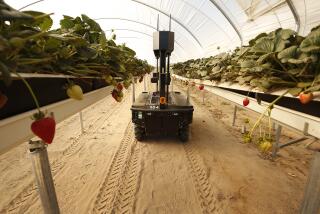Not More Workers but Better Wages
Big California agriculture is again clamoring for more foreign labor to work in the fields. In spite of the fact that the General Accounting Office, after extensive study, has concluded that there is an overabundance of farm labor, the industry has begun flexing its considerable political muscle to get still more foreign labor.
Ironically, in arguing its case for more guest workers and less strict enforcement of laws against illegal immigration, lobbyists for the industry detail precisely why their demands should not be met. In a recent news story in The Times, a farmer complained that unemployed people are not eager to work the fields for the minimum wages being offered. The news story also noted that lack of adequate transportation and child care were impediments to filling farm jobs with local workers.
What the industry seems to be saying is that there isn’t a shortage of available labor. Rather, the problem is unattractive wages and working conditions. The solution favored by the employers is to import foreign workers who will accept the wages being offered and live in temporary on-site housing. A better solution, however, is to make agriculture compete for labor the way other industries do, by improving wages and developing innovative ways to overcome transportation and day care obstacles.
The cost of field labor represents only about 10% of the final price consumers pay for produce at the supermarket. Therefore, there is room for substantial improvement in farm wages that would be barely noticeable in market prices of fruits and vegetables. Workers who might be unwilling to toil for minimum wage may be attracted to those jobs at wages that will enable them to support themselves and their families.
The problems of transportation to get unemployed workers in places like Fresno and Modesto to jobs in nearby fields or providing day care for their kids cry out for public-private cooperation. It is in the interest of farmers to find people to work in the fields and it is in the interest of state, county and local governments to move people off of welfare and onto payrolls. Some sort of shared arrangement to provide transportation and child care would be a win-win proposition.
Opening the doors to more foreign guest workers and turning a blind eye to illegal immigration is socially and fiscally irresponsible. Creating a permanent and growing caste of workers who can never improve their economic lot in life because they are constantly competing with an endless supply of foreign labor is the most socially destructive phenomenon since slavery. Moreover, low wage labor is cheap only to the employer. The enormous social and fiscal costs for services like education, health care and food stamps must be borne by taxpayers.
No state offers a better laboratory than California to devise a creative plan that reconciles the legitimate needs of employers with the interests of the public. The perishable nature of California agriculture demands a flexible farm labor pool. Agricultural unemployment rates of 20% to 30% indicate that the supply of workers is more than adequate. What is lacking are incentives to match available workers to available jobs.
Virtually all the labor needs of the United States can be met with our existing supply of workers if wages, working conditions and productivity are improved. California farmers will surely have to pay higher wages to attract the workers they need. In an era of global trade and competition, this is not a minor problem, but it is a surmountable one that many other American industries have overcome.
In the long run, a combination of increased investment in mechanization and improved utilization of the existing labor force will lead to increased productivity and, ultimately, better wages and working conditions for farm workers. This will enhance, not diminish, the competitive position of California agriculture.
More to Read
Inside the business of entertainment
The Wide Shot brings you news, analysis and insights on everything from streaming wars to production — and what it all means for the future.
You may occasionally receive promotional content from the Los Angeles Times.










